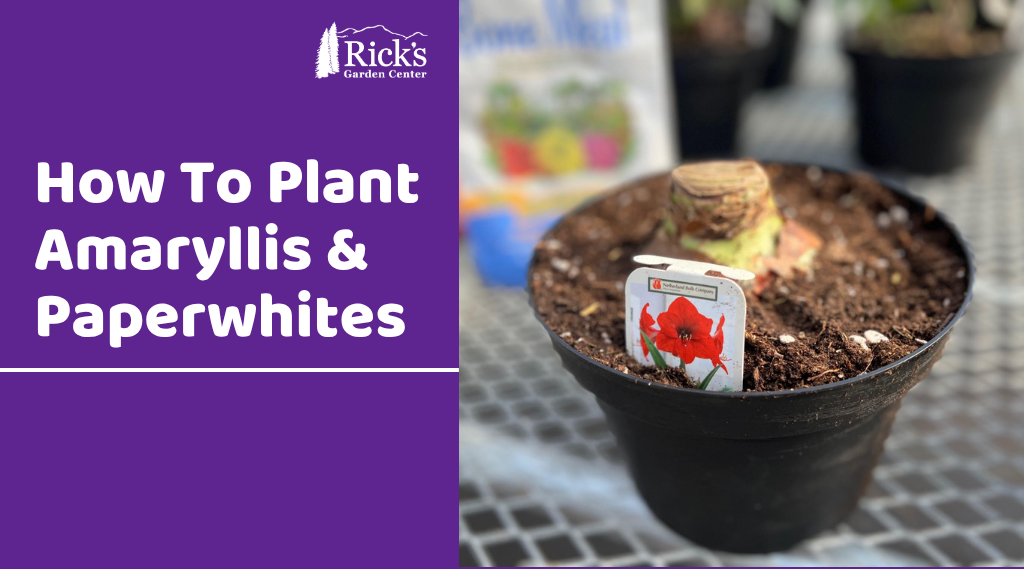How To Plant Amaryllis & Paperwhites
Our holiday bulbs are here! Make way for Amaryllis & Paperwhites! Because these plants need to be planted about eight to ten weeks in advance, to flower around Christmas, we thought we’d provide this care guide now. Caring for and planting these bulbs is surprisingly easy!
How To Plant Holiday Bulbs
Ingredients:
-Bulbs, one Amaryllis or ten to eight Paperwhites.
-Well-draining soil (we’re using Fertilome Ultimate Potting Soil).
-8 Inch Container.
-Bulb fertilizer (we’re using both blood meal and bone meal).
Step-By-Step Guide
1.) Let’s start with the substrate. To prevent rot, pick soil with excellent drainage for these bulbs. We prefer Fertilome Ultimate Potting Soil, but Fox Farm’s Happy Frog works too. Gardners occasionally plant Amaryllis in a succulent mix, replicating their natural arid environment. Be cautious with this approach because it requires more watering due to extremely well draining soil.
2.) Once your soil is selected, fill about two-thirds of the container of your choice. Here, for both paperwhites and amaryllis, we’re using an 8 inch nursery injection pot. But you can use any kind of container. Having a hole for drainage is essential, and bulbs need some wiggle room.
3.) We advise fertilizing bulbs with a slow-release organic fertilizer. Whilst bulb-specific fertilizer, like Espoma Bulb-Tone, is ideal due to phosphorus levels, a flower fertilizer likewise works. Here, we choose to use blood meal and bone meal, high sources of nitrogen and phosphorus. We’ll eyeball the amounts because with them organic and a slow-release fertilizer burn isn’t a high concern.
4.) Plant your bulbs! Make sure roots are pointing down to the bottom of the pot, tip pointing to the sky. In fact, about one-third of the top of the plant should be above the soil. Amaryllis should have an inch and a half of space around the bulb and enough depth to properly root out. Paperwhites can be planted close together, but bulbs shouldn’t be touching. Think of how an egg carton is arranged! They should also have good depth for their roots to grow.
5.) Now, give the bulbs a light water. This helps pack them in. Rot is the primary cause of death for bulbs, so maintaining a good watering schedule is essential for their survival. We recommend watering every other day in a dry environment, less so in a humid environment. Lower watering to once every four days once green sprouts appear.

Forcing Paperwhite Narcissus Bulbs
 Flowering bulbs can be forced to bloom indoors, creating a beautiful display of color and fragrance even on the coldest days of winter. Some bulbs require a period of cold treatment to bloom, which can be a little tricky. If you’re new to forcing bulbs, we recommend starting with Paperwhite Narcissus. Paperwhite bulbs do not require a cold treatment and are super easy to bloom in water.
Flowering bulbs can be forced to bloom indoors, creating a beautiful display of color and fragrance even on the coldest days of winter. Some bulbs require a period of cold treatment to bloom, which can be a little tricky. If you’re new to forcing bulbs, we recommend starting with Paperwhite Narcissus. Paperwhite bulbs do not require a cold treatment and are super easy to bloom in water.
Planting – A Simple Hydroponic Method
- Find a decorative bowl or dish that is 3 to 4 inches deep and holds water
- Fill the dish with about 2 to 3 inches of clean decorative rock, pebbles, pea gravel, perlite, or other very porous substrate leaving about 1 inch of head space at the top of the dish
- Add water until it is just slightly below the surface of the rock
- Set the bulbs on top of the rock with the basal plate (root end) facing down
- Use a little more gravel to cover the bottom quarter of the bulb
Maintaining
- Keep the water level just at the level of the basal plate (too much water will cause the bulb to rot)
- Bulbs typically do best if they are kept in a cooler location (50 to 60 degrees F) in low light for the first 2 to 3 weeks
- Once the bulbs are rooted and shoots appear, bring into direct sunlight and warmer temperatures
- When the flower buds begin to show their color, move the plants into indirect sunlight to prolong the flowers
Pro Tips
- Plant new pots every two weeks starting in mid-October to have blooms from Thanksgiving into March.
- Keep bulbs out of reach of pets and children as these plants are toxic if ingested.
- Forced paperwhites will not likely rebloom, so it is best to toss out spent bulbs.
References: